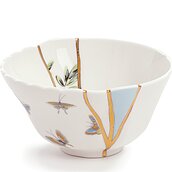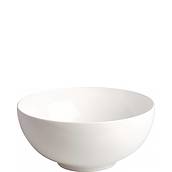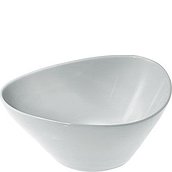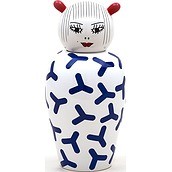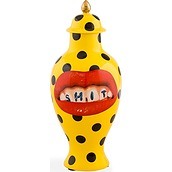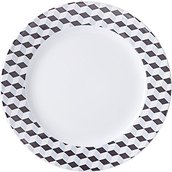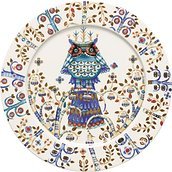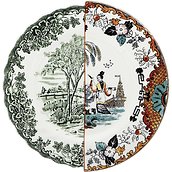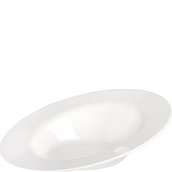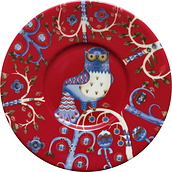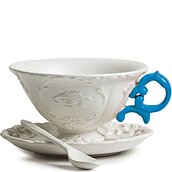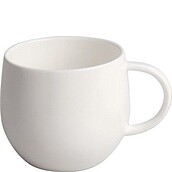Porcelain. A secret strictly guarded
Valued like gold for hundreds of years, porcelain still decorates tables all over the world. However, before it took over our homes, its recipe was kept a secret strictly guarded by the Chinese. When was porcelain invented? How did it come to Europe? What does its name mean? You will learn all of this from our magazine!
It is well known that China is the home of an infinite number of discoveries and inventions. As Charlie Chaplin once said:
The wisest nation in the world is undoubtedly the Chinese. They invented printing - but not newspapers, powder - but only for fireworks, and then a compass - but they stopped themselves from discovering America.
Fortunately, however, nothing stopped them from discovering one of the most valuable elements of world design and, at the same time, an integral part of every dining room and kitchen, namely porcelain.


For a good start
According to the legend, one day a Chinese craftsman decided to stick the wicker skeleton pieces with clay and set it on fire. The effect was surprising. Although the wicker construction burned down, the clay turned into a hard shell, opening a completely new chapter in the world heritage history.
Since the invention of the potter's wheel, the craftsmen no longer had to rely on the skeletons prepared beforehand, and they eagerly devoted themselves to forming vessels of completely new shapes and sizes. As early as the 7th century A.D., the first white vessels known as porcelain ones were being burnt. In the process of burning a mixture of aluminium at a temperature of over 1280 degrees Celsius, the material was created which did not let water through it, despite it being semi-transparent. The Chinese were amazed by their invention, and the porcelain bowls and vases stormed to the richest mansions and palaces in the country.
At the Imperial Court
The porcelain industry in China developed dynamically, contributing to the creation of over a hundred manufactures, which supplied households of the rich with everyday utensils, temples with cult objects and, finally, imperial palaces with everything that their rulers wanted. During the reign of the Yuan Dynasty, the Jingdezhen manufactory gained the title of China's Porcelain Capital, and its products became models of artistic craftsmanship, technique and beauty. The "Golden Age" of porcelain in China fell during the reign of the Qing Dynasty (1644-1911), when new techniques of glaze painting led to unprecedented colours and patterns of vessels. Among other things, the famous vases which in pop culture are often used as a part of very rich and elegant interiors, come from this period.
An interesting fact
Of course, what would the famous works of culture be if they did not become an inspiration for future generations! It is worth paying attention to e.g. the porcelain vases of Seletti brand, which playfully relate to tradition and, at the same time, break conventions.Porcella in Europe
Even the Europeans could not resist the charm of the Chinese porcelain, and the first to admire its subtle beauty was a traveller, Marco Polo, who in 1298, after his trip to China, mentioned a vessel in his diary, which he described as 'porcella', meaning a shiny shell in Italian. This term was adopted in Europe only in the 16th century and thanks to the Portuguese Vasco da Gama, who discovered the sea route to India, two hundred years later porcelain, along with spices and silk, arrived in European ports. Although its price was even higher than that of silver, porcelain products quickly gained recognition and admiration among the wealthiest.
Not without significance
From the very beginning of its existence, porcelain has been an indicator of social status. Therefore, porcelain products were collected extremely carefully at the courts of the Chinese and the Japanese emperors, and over time they even became a kind of currency. For example, porcelain was used to obtain official administrative positions. In Europe, too, rich families and royal courts could not resist the fashion for porcelain trinkets, which wealthy monarchs and magnates wanted to boast about to their neighbours. As a result, even special rooms called "porcelain offices" were created in the most significant estates, in which the most valuable collections were gathered.
An interesting fact
The popularity of porcelain at the courts of European rulers was also intensified by the superstition that porcelain dishes break into pieces upon contact with the poison added to the food or drink served on them. Therefore, rulers ate on porcelain plates and bowls.In the search of a recipe...
No wonder that European scholars have been trying for many years to discover the secret of producing this particular variety of ceramics. However, it was not as easy as it might seem, because the Chinese kept their secret. It was first achieved by the French alchemists of the Renaissance era in 1560 in Florence. The so-called Medici porcelain was created at that time, from the name of Francesco Maria de Medici, who currently reigned at the court. In 1670, frit porcelain was created, of which the most famous example, and at the same time one of the few preserved objects of this kind so far, is a councilman's coat of arms painting, a mustard dish. However, both types of porcelain invented so far in Europe were the varieties of soft porcelain. The first European hard porcelain, kaolin, was not created until 1709 in Dresden, and its accidental discoverer was an alchemist looking for a way to turn metal into gold, Johan Fryderyk Boetgger. In 1745, Englishman Thomas Fry invented another variety, bone china, produced from incinerated bones of cattle (hence the popular name bone china), feldspar and kaolin. This porcelain is distinguished by its high level of whiteness and clarity, and is produced to this day and is used to make white cups, among other things.



From the lab to Meissen and Limoges
August II the Strong, who deeply believed in Boetgger's skills and took care of him, did not get what he expected. Gold production failed. However, when the alchemist gave him porcelain, initially called "white gold" and then "Saxon porcelain", the king was so impressed that he moved the laboratory from Dresden to Meissen, where soon the most famous European porcelain manufactory was established. In the second half of the 18th century, the famous hard porcelain centre in Limoges was also established, whose products are appreciated worldwide for their excellent quality and a unique design. There is also a porcelain museum in Limoges, which has the most beautiful collections in the world.
By contrast, the first Polish porcelain manufactory was established in Korc (which today belongs to Ukraine) in 1784. Although it did not work for a long time (only until 1832), it laid the foundations for the great Polish love for porcelain, which resulted in creating more factories throughout the country. Some of them, such as the famous Ćmielów, which dates back to 1790, or Kristoff, still operate today and create beautiful products, such as cups or plates.
Not only tableware
Porcelain was and is still used not only to make classic dishes and tableware, but also other items such as figurines, fireplaces and table decorations, tiles or bathroom ceramics. In times of the Chinese glory, porcelain dishes were also used as musical instruments. It should be remembered that only the highest quality porcelain produces a clear and a loud sound. The Chinese also used porcelain cups as a gambling tool. Players filled porcelain cups with tea, and the winner was the one whose tea evaporated the last. The key to success was the thickness of the walls - thin-walled porcelain holds the heat, making the drink evaporate slowlier, and the colour - a cup which had a cleaner whiteness better reflects the sunlight and prevents the pot from heating up.
Do you know...
how porcelain is different from porcelite or faience? This and many other things you can find out from our magazine: Stoneware, faience, porcelain - a guide to the types of ceramics.A positive addiction
The already mentioned August II the Strong once said that
Porcelain is like oranges - if you get sick of one or the other, you never get enough of it and always want to have more.
Therefore, without any hesitation, one can say that love for porcelain is addictive and it is a feeling worth taking care of.
